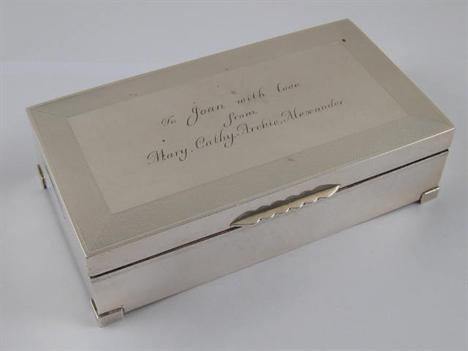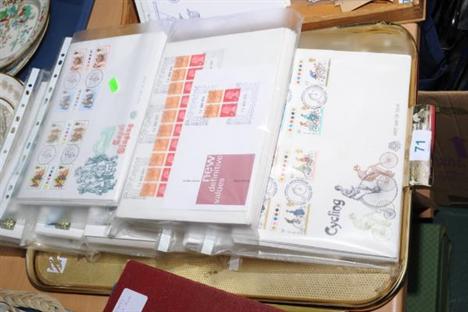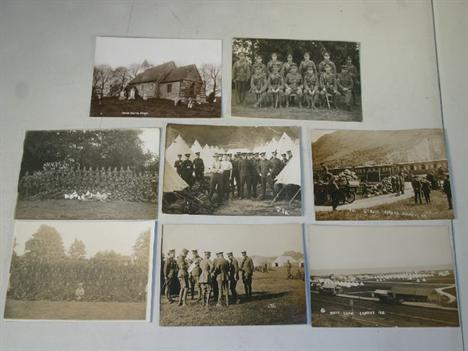A collection of coloured framed and glazed maps of Wales comprising map of Montgomeryshire and Merionethshire, from a folio map from Novus Atlas by Joannes Janssonius c.1646, being a double glazed map showing the scripts on the verso, from the edition a New Description of England and Wales c.1724, 38x49cm, South Wales by Herman Moll c.1724, 23x34cm, North Wales by H Moll from the edition a New Description of England and Wales c.1724, 22x34cm, North Wales, a new map of North Wales drawn from Best Authorities by Thomas Kitchin c.1764, 23x29cm, South Wales engraved by R Scott c.1836, 20x25cm and North Wales published by John Cary Engraver & Map Seller, Strand, London, from Curries New and Correct English Atlas first published 1787, this being a copy from the 1818 or later edition, 24x28cm (6) (illustrated)
We found 596772 price guide item(s) matching your search
There are 596772 lots that match your search criteria. Subscribe now to get instant access to the full price guide service.
Click here to subscribe- List
- Grid
-
596772 item(s)/page
Five Beswick models of horses comprising `Prancing Arab` version one in palomino colour (af), `Prancing Arab` version one in brown gloss colourway, `Hackney` in black gloss colourway, `Welsh Mountain Pony` first version in grey colourway (af) and `Small Thoroughbred Stallion` in mat brown colourway
A brass bound mahogany barograph Elliott Bros., London, early 20th century With eight-part vacuum chamber within lacquered brass armature operating inked pointer for the clockwork driven rotating paper-scale lined drum the interior applied with ivorine plaque ELLIOTT BROS, LONDON beneath five panel bevel glazed cover with brass edged top and bottom rails, on ogee moulded base with chart drawer to apron, 36cm wide. Provenance: the base is applied with a brass plaque inscribed ADMIRALTY PRIZE, FOR FIVE FIRST CLASS CERIFICATES ,1905, SUB-LIEUTENANT CUTHBERT D. LONGSTAFF R.N..
A Regency mahogany mercury wheel barometer Sordelli, early 19th century The 10 inch scroll-centre engraved circular silvered register calibrated in inches and with the usual observations, beneath brass edged circular convex mirror, arched mercury Fahrenheit scale thermometer and hygrometer to the swan neck pediment, the rounded base with spirit level signed Sordelli, Warranted beneath setting pointer adjustment key, the case with ebony and box strung edges, 105cm high. Several makers with the surname Sordelli are recorded in Banfield, Edwin BAROMETER MAKERS AND RETAILERS 1660-1800 working in London during the first half of the 19th century.
A rare Victorian oak FitzRoy forecasting stick barometer Negretti & Zambra, London, mid to late 19th century With moulded pediment above rectangular bevel glazed double enamel vernier scales calibrated in inches and annotated LONG FORETOLD LONG LAST SHORT NOTICE SOON PAST to the 10 A.M. YESTERDAY scale and FIRST RISE AFTER LOW FORETELLS STRONGER BLOW to the 10 A.M. TODAY scale, signed NEGRETTI & ZAMBRA, INSTRUMENT MAKERS TO HER MAJESTY, 1 HATTON GARDEN E.C., 122 REGENT St. W. & 59 CORNHILL E.C., LONDON to upper margins and numbered (1024) to lower margins, around a large bore tube, the sides applied with brass framed wet and dry mercury Fahrenheit thermometers scales above double vernier adjustment screws to throat and further large bevel glazed mercury thermometer with repeat signature to the enamel scale, the rectangular base with ogee moulded cistern cover and cavetto moulded underside with level adjustment screw, 102cm high. Provenance: Private collection, Gloucestershire. The basic form of the current lot is similar to that of a Fishery or Sea Coast storm barometer originally devised by Admiral Robert FitzRoy in the 1860`s to aid mariners in the forecasting of storms. The addition of wet and dry tube thermometers provides the observer with a reasonably accurate hygrometer allowing more accurate prediction with regards to cloud and rainfall to be made. The firm of Negretti & Zambra are recorded in Banfield, Edwin BAROMETER MAKERS AND RETAILERS 1660-1900 as being established in 1850 when a partnership between Enrico Negretti and Joseph Warren Zambra was formed. The firm became one of the most prolific makers of scientific instruments and continued trading well into the 20th century.
FitzRoy, Rear Admiral Robert THE WEATHER BOOK: A MANUAL OF PRACTICAL METEOROLOGY Longman, Green, Longman, Roberts, & Green, London 1st edition 1863, 16 lithographed charts, tables and plates at end, including many folding or double-page and two on blue paper, bound in tooled blue cloth; with a group of 14 further meteorological related works including Steinmetz, Andrew SUNSHINE AND SHOWERS, Reeve & Co., London 1867; Reid, Lieut-Colonel William THE PROGRESS of the DEVELOPEMENT of THE LAW OF STORMS and of THE VARIABLE WINDS John Weale, London 1849 (binding incomplete); Buchan, Alexander M.A. A HANDY BOOK OF METEOROLOGY William Blackwood and Sons, Edinburgh and London 1867 and Lowe, Edward Joseph A TREATISE on ATMOSPHERIC PHAENOMENA Longman, Brown, Green and Longmans, Nottingham 1846, (15). Vice Admiral Robert Fitzroy started his colourful Naval career at the age of twelve in 1818, he later became Captain of the Beagle, and in 1831 made history when he agreed to accept Charles Darwin to accompany him on a voyage of scientific discovery. Although Fitzroy became good friends with Darwin he later regretted their association due to his strong Christian beliefs. In 1841 Fitzroy was elected MP for Durham before being recommended by The Church Missionary Society to be appointed Governor of New Zealand, a position which he took up in 1843. Unfortunately tensions which led to the First New Zealand War resulted in him being replaced by Governor George Grey in 1848. On his return he was given his last Naval Command before retiring to shore duty in 1851. It was during these later years that he was able to focus on his lifelong interest in meteorology. In 1854 he was appointed head of the department that was later to become The Meteorological Office and, after the severe storm of 1859 (which resulted in the loss of the vessel the Royal Charter), he co-ordinated the creation of fifteen weather stations around the country and the publication of daily weather forecasts in The Times. His research into weather forecasting led to the development of improved barometers and methods of interpretation of data culminating in the publication of The Weather Book in 1863. Unfortunately debt and his lifelong struggle with depression got the better of him as he comitted suicide on 30th April 1865.
A pair of horological limited edition photolithographic reproductions David Penney, 1981 The first of a phase II Roman striking table clock by Joseph Knibb, with The Clockmakers Company 350th year commemorative blindstamp, signed and numbered 219/250; the second of an early marine timekeeper by John Arnold & Son (number 50), also signed, with blindstamp and numbered 250/250, each 37 x 58cm to mount.
Photograph of Spencer Ewart 1913, Brig. Gen. Charles hale Munro CB, drawing of monument to Sir Charles Brisbane KCB erected in the Island of St Vincent, scrap album First World War obituary newspaper cuttings for Lt. Douglas B Stamp 1st Batt E Yorks Regt, photograph album of The British Army of the Rhine 1925-26, 2nd Cameron Highlanders in Wiesbaden 1925, Sir John & Lady Du Cane Marshal and Madame Guillemand, Ball, Common Riding and Douglas Jones Occasional verse with preparatory notes
William Wood (1769-1810); a fine portrait miniature of Captain Birch, facing right, in blue coat with white waistcoat, signed on reverse and dated 1805, in rectangular ebonised frame with gilt bezel, 8.5 x 7cm. Captain Birch commanded the East India Ship "The Britannia". Britannia was built in 1806 by Wells & Co, London and owned by the East Indian Company. Launched in 1806, her first voyage was to Bombay and China under Captain Jonathan Birch, departing from Portsmouth 26th Feb 1807 and returning 1st July 1808. On the second voyage in 1808/9 to Madras and China under Captain Jonathan Birch, she ran aground and was lost off Goodwin Sands on 24th January 1809 (Illustrated).
A comprehensive collection of GB stamps and first day covers, including penny black, penny reds, some on 19th century envelopes, contained in twelve albums/packs and some loose, also including the Sumner collection of 22ct gold stamp replicas, sterling silver miniatures with certificate, American share certificates etc.
A c1700 copy of XII sonatas or solos for a violin a bass violin or harpsicord compos`d by Arcangelo Corelli his fifth opera". This edition has ye advantage of having ye graces to all ye adagios and other pieces where the author thought proper by Arcangelo Corelli. There is likewise engraven his first second third & fourth operas being all the works of that author yet extant London. Printed for J. Walsh servt. to her majesty at ye Harp & Hoboy in Katherine Street in ye Strand & J. Hare at ye viol & flute in Cornhill nere ye Royal Exchange. Having been professionally re-bound and restored to a high standard."
A silver navette half reeded sugar basin by The Goldsmiths & Silversmiths Co. Ltd, Sheffield 1901, engraved with a crest and a motto `Nobilis Est Ira Leonis`, 16cm (6.25in) long; a late Victorian tapered cheroot holder case, Birmingham 1898; various small flatware; and an American silver coloured butter knife, 11.75 oz gross The crest and motto belongs to the name of Stuart, a kinsman of the Marquesses of Bute. The first husband of Mrs Knatchbull Hugesson of Ropley House was Lord James Charles Crichton-Stuart, son of Sir John Crichton-Stuart, 5th Marquess of the County of Bute and Lady Eileen Beatrice Forbes. Provenance: Ropley House, Alresford, Hampshire
Seven historic sepia postcards relating to the First World War and the army camp then located at what is now the Conwy (Caernarfonshire) Golf Club, one card showing the Whit Camp, Conwy 1912, another showing members of the Sixth Battalion of The Lancashire Fusiliers disembarking at a nearby mainline station and five related postcards of army personnel, one showing soldiers by their tents with Conwy Mountain as a backdrop
-
596772 item(s)/page




























































